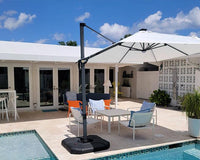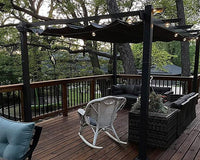An aluminum pergola is a fantastic addition to any outdoor space, offering a perfect blend of shade, style, and low maintenance. However, its lightweight nature can make it vulnerable to strong winds and driving rain. Protecting your investment is not just about preserving its beauty, but also about ensuring safety. This guide will provide you with practical, no-nonsense steps to fortify your aluminum pergola against the harshest weather.
Why Aluminum Pergola Anchoring is Everything
If you take away only one thing from this guide, let it be this: your pergola's strength comes from its connection to the ground, so whether to anchor it depends on the actual situation. A pergola that isn't anchored down securely is just waiting for a powerful gust to turn it into a problem. How you anchor it all comes down to what it’s standing on.
On a Concrete Patio
If your pergola is on a concrete slab, you'll want to use heavy-duty concrete anchors—sleeve or wedge anchors are perfect for this. Grab a hammer drill with a masonry bit and drill holes where the post bases will go. Make sure the holes are the right size and depth for the anchors you bought.
Before you put the anchors in, get all the dust out of the holes with a shop vac or blower. A clean hole means a tighter grip. Then, slide the anchors in and tighten them down until the post bases are rock solid against the patio. This will keep the posts from lifting or shifting in the wind.
On a Wooden Deck
When mounting a pergola to a deck, you have to go deeper than just the floorboards. The posts need to be bolted directly to the deck’s frame—the joists or beams underneath. This is a critical step. Use strong, corrosion-resistant hardware like galvanized lag screws or through-bolts to make the connection.
Position your post bases over the joists, drill some pilot holes, and bolt everything down tight. This way, any force from the wind gets transferred to the solid structure of your deck, instead of just ripping the floorboards up.

On Grass or in the Dirt
For installations in your yard, you can't just set the posts on the ground and hope for the best. You need to pour concrete footings. Dig holes that go deeper than the frost line in your area, which is usually about 24 to 36 inches deep. This stops the ground from pushing your footings up when it freezes and thaws.
Set a cardboard tube form in each hole and fill it with concrete. Before it starts to harden, sink a J-bolt or another post anchor into the wet concrete, making sure it’s level and in the right spot. Once the concrete is fully cured, you'll have an incredibly strong base to bolt your pergola posts to.
Beef Up the Aluminum Pergola Frame for Big Storms
Even though aluminum is tough, a little extra reinforcement can give you a lot of peace of mind when the weather gets wild. Strong winds can push, pull, and twist a structure in ways you might not expect.
- Add Corner Braces: Putting diagonal braces where the beams and posts meet is a simple way to make the whole structure much more rigid. These braces create strong triangles that stop the frame from wobbling or swaying in the wind.
- Use Hurricane Clips: If your pergola has a more traditional roof structure, hurricane clips are a smart move. These little metal connectors reinforce the spots where the roof rafters attach to the main beams, making it much harder for the wind to lift the roof off.
- Choose Thicker Aluminum: If you're still shopping for a pergola and live in an area that gets its fair share of storms, look for a pergola made with a thicker gauge of aluminum. A heavier frame is naturally going to stand up to wind better from the get-go.
Managing Rain and Water Drainage
The majority of open-roof pergolas are not 100% waterproof, but you can definitely manage the rain to protect your patio furniture and the area beneath it. If there is no provision for drainage, water may pool, causing extra weight and problems down the line.
One of the optimal solutions is to put in polycarbonate or metal roof panels along the top. These are light, long-lasting, and you can even get clear ones that will let the sun shine through. Just make sure that you place them at a slight angle so the water will run off.
To control that runoff, a simple gutter and downspout system is your best friend. Place a gutter along the low edge of the roof to gather the water and direct it away from the foundation of your pergola. This keeps the ground around the posts from becoming saturated, which could cause the footings to weaken over time.

Special Considerations for Louvered and Retractable Roofs
Pergolas with louvered or retractable roofs are awesome for their flexibility, but they need a little extra attention before a storm. Those moving parts can be vulnerable if you don't prepare them.
Louvered Roofs
When you know a big storm's coming, your best bet is to open those louvers all the way. This lets the wind pass right through instead of pushing against the roof like a giant sail. If you leave them closed, you're creating a huge surface area for the wind to catch, which could damage the louvers or even the frame itself.
Retractable Canopies
The retractable pergola is great for sun, but it's no match for high winds or heavy rain. Always, always retract the canopy fully into its housing before a storm. If you leave it out, you're just asking for it to get torn, stretched, or for the sheer weight of pooling water to break the mechanism.

4 Tips in Pre-Storm Checklist and Regular Maintenance
Proactive maintenance is key to ensuring your pergola is always ready to face a storm. Don't wait until a severe weather warning is issued to check your structure.
- Inspect Fasteners: At the beginning of each storm season, check and tighten all nuts, bolts, and screws. Vibrations from wind can cause them to loosen over time.
- Clear Debris: Regularly clear any leaves, branches, or other debris from the roof, gutters, and around the base of the posts. Clogged gutters can lead to water overflow and potential damage.
- Check for Corrosion: While aluminum is rust-resistant, it's still wise to inspect for any signs of corrosion, especially around steel fasteners. Address any issues promptly to maintain structural integrity.
- Remove Loose Items: Before a storm hits, remove any hanging plants, string lights, furniture, or grills from the pergola area. These can become dangerous projectiles in high winds.
By being diligent and taking these protective measures, you can ensure your aluminum pergola remains a safe and beautiful feature of your home for many years. It's about working with the elements, not against them, and a little preparation goes a long way in shielding your outdoor oasis from wind and rain.




